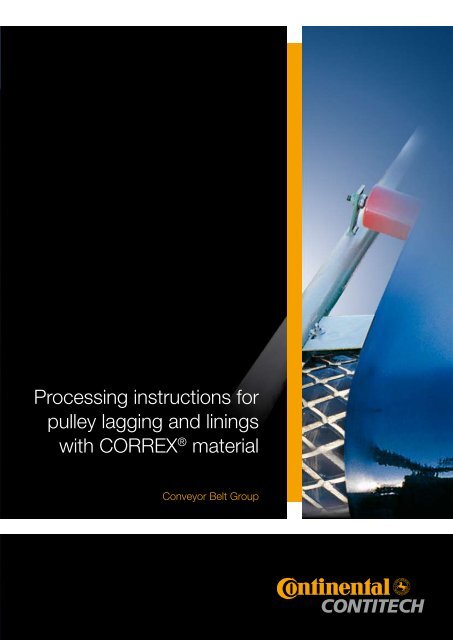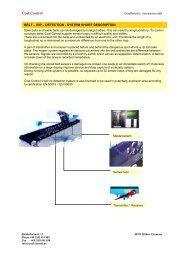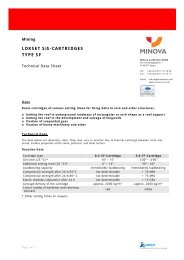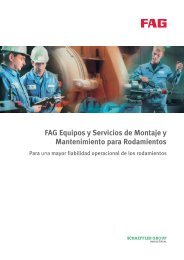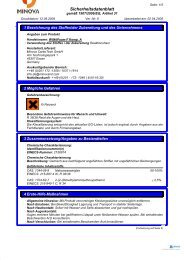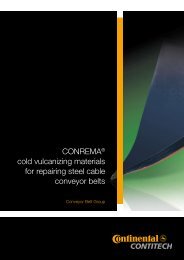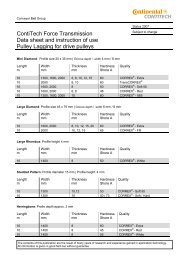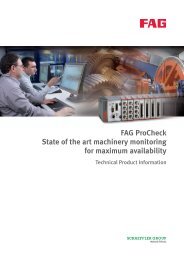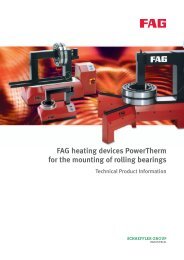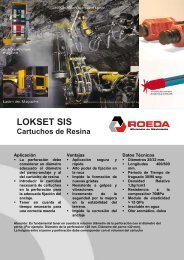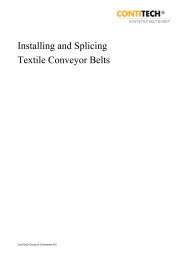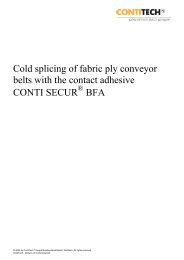Processing instructions for pulley lagging and linings with CORREX ...
Processing instructions for pulley lagging and linings with CORREX ...
Processing instructions for pulley lagging and linings with CORREX ...
You also want an ePaper? Increase the reach of your titles
YUMPU automatically turns print PDFs into web optimized ePapers that Google loves.
<strong>Processing</strong> <strong>instructions</strong> <strong>for</strong><br />
<strong>pulley</strong> <strong>lagging</strong> <strong>and</strong> <strong>linings</strong><br />
<strong>with</strong> <strong>CORREX</strong> ® material<br />
Conveyor Belt Group
ContiTech Conveyor Belt Group<br />
List of Contents<br />
3 Introduction<br />
4 General Instructions<br />
6 Tables<br />
10 Preparing the Pulley Surface <strong>and</strong> the Pulley Lagging<br />
12 Lining the Pulley – Butt Joint Type<br />
15 Lagging the Pulley – Overlap Joint<br />
18 Lagging the Pulley – V-Joint<br />
22 Abrasion Protection <strong>with</strong> <strong>CORREX</strong> ® Lining Material
Introduction<br />
Operational readiness, reliability <strong>and</strong> the working life of any conveying system are<br />
all factors which depend on the system being appropriately equipped, serviced<br />
<strong>and</strong> maintained.<br />
The equipment features which contribute most to the operational readiness are<br />
those which promote the straight tracking, cleanliness <strong>and</strong> upkeep of the conveyor<br />
belt itself.<br />
Coating some wearing parts <strong>with</strong> <strong>lagging</strong> made of specially developed rubber materials<br />
<strong>with</strong> a profiled surface has - over many years of deployment - stood the test<br />
of time <strong>and</strong> contributed to the reliability of the conveyors.<br />
Profiled rubber <strong>lagging</strong> on the drive <strong>pulley</strong> increases the co-efficient of friction<br />
between the <strong>pulley</strong> <strong>and</strong> the conveyor belt, ensuring friction grip even under the<br />
most adverse conditions such as moisture <strong>and</strong> soiling etc.<br />
Moreover, <strong>pulley</strong> <strong>lagging</strong>s are also used as a protection against both abrasion <strong>and</strong><br />
noise in those places where surfaces at pick-up points, transfer points <strong>and</strong> bunkers<br />
are particularly vulnerable to attack.<br />
<strong>CORREX</strong> ® rubber sheeting <strong>with</strong> an adhesive layer was designed by ContiTech <strong>for</strong><br />
a different arrays of applications.<br />
The numerous technological properties of the rubber materials as well as the wide<br />
range of corrugated surfaces combine to cater <strong>for</strong> the most varied requirements.<br />
<strong>CORREX</strong> ® adhesive layer rubber sheeting used in conjunction <strong>with</strong> CONTI PLUS ®<br />
Metal Primer <strong>and</strong> CONTI SECUR ® BFA Contact Adhesive will guarantee high<br />
adhesion values, if expertly applied during the cold bonding process.
ContiTech Conveyor Belt Group<br />
General Instructions<br />
Material, Pulley Lagging <strong>and</strong> Abrasion Protection<br />
– suitable <strong>for</strong> both over- <strong>and</strong> underground deployment, depending on the<br />
individual material.<br />
Storage according to DIN 7716<br />
– store in a cool, dry <strong>and</strong>, if possible, dark place<br />
– recommended storage temperature: 20 °C<br />
– keep away from oil <strong>and</strong> grease<br />
Preparing the Bonding Surface <strong>and</strong> the Sheeting Material<br />
– remove any rust <strong>and</strong> dirt by means of s<strong>and</strong>blasting or s<strong>and</strong>papering <strong>and</strong> clean<br />
the surface thoroughly<br />
– sweep off all traces of chippings <strong>and</strong> dust carefully<br />
– wash the entire surface <strong>with</strong> cleaning agent RCE<br />
– stir the CONTI PLUS ® Metal Primer thoroughly<br />
– apply CONTI PLUS ® to the metal surface, spreading it thinly at a recommended<br />
rate of about 100 g/m²<br />
– allow the coating of CONTI PLUS ® to dry completely; this requires a minimum<br />
of 30 minutes <strong>and</strong> maximum of three weeks at room temperature<br />
Attention!<br />
The parts which are coated <strong>with</strong> bonding agent have to be stored<br />
dust-free.<br />
– mix CONTI SECUR ® BFA <strong>with</strong> the activator solution <strong>and</strong> stir well; the activated<br />
cement can be used <strong>for</strong> 2 to 5 hours<br />
Attention!<br />
CONTI PLUS ® <strong>and</strong> CONTI SECUR ® BFA is not authorised <strong>for</strong> underground use.<br />
<br />
– the following advice must be heeded when working <strong>with</strong> CONTI SECUR ® BFA :<br />
• slightly flammable - do not smoke<br />
• avoid breathing in the fumes<br />
observe the MAC limits (maximum allowable concentration)<br />
• if the concentration is higher, then wear a breathing mask fitted <strong>with</strong> A2-filter<br />
– apply the first coat of CONTI SECUR ® BFA <strong>with</strong> a bristle brush thinly<br />
– let the first coat dry thoroughly<br />
• Drying time at room temperature (22° C - 25° C) is at least 30 minutes<br />
– the <strong>CORREX</strong> ® material should be cut to the required shape during the first <strong>and</strong><br />
second applications on the metal surface<br />
– apply the second coat of CONTI SECUR ® BFA thinly<br />
• Drying time: back of the h<strong>and</strong> test, max. 15 minutes<br />
– remove the protective foil from the <strong>CORREX</strong> ® adhesive layer<br />
– immediately after the second coating of the metal surface, apply the CONTI<br />
SECUR ® BFA to the adhesive layer thinly<br />
– allow the adhesive layer coating to dry until.<br />
• Drying time: back of the h<strong>and</strong> test, max. 15 minutes
Mounting the Sheet Material<br />
– when the CONTI SECUR ® BFA coats on the metal surface <strong>and</strong> on the adhesive<br />
layer of <strong>CORREX</strong> ® sheeting are still tacky, lay carefully from inside to outside<br />
– lay the <strong>CORREX</strong> ® <strong>lagging</strong> by winding it on to the surface <strong>and</strong> pressing it down<br />
so that no air bubbles are trapped underneath<br />
Attention!<br />
Do not pull up the <strong>lagging</strong> after laying it! If such corrective measures are<br />
undertaken - e. g. if the sheet is pulled up - the coat of CONTI SECUR ® BFA will<br />
damage the <strong>pulley</strong> surface. The damaged area must then be retreated <strong>with</strong> a<br />
single coat of CONTI SECUR ® BFA.<br />
• Drying time: back of the h<strong>and</strong> test: max. 15 minutes<br />
– using a h<strong>and</strong> roller, press down from the centre outwards<br />
– finally, the <strong>lagging</strong> should be hammered flat <strong>with</strong> a suitable mallet<br />
Commissioning<br />
With cold cements, the adhesion properties increase over a longer period.<br />
The conveyor may be put back into service after at least five hours.
ContiTech Conveyor Belt Group<br />
Tables<br />
Recommendations <strong>for</strong> <strong>lagging</strong> thickness <strong>and</strong> material per<strong>for</strong>mance <strong>for</strong> bend, tension <strong>and</strong><br />
snub drums are dependant on the belt tension<br />
low belt tension<br />
high belt tension<br />
drum diameter<br />
<strong>lagging</strong><br />
thickness<br />
<strong>lagging</strong><br />
thickness<br />
mm<br />
mm<br />
mm<br />
up to 315 <strong>CORREX</strong> ® - approx. 45 Shore A 10 <strong>CORREX</strong> ® - approx. 60 Shore A 8<br />
315 - 630 <strong>CORREX</strong> ® - approx. 45 Shore A 15 <strong>CORREX</strong> ® - approx. 60 Shore A 10<br />
over 630 <strong>CORREX</strong> ® - approx. 60 Shore A 12<br />
The recommendation <strong>for</strong> drive drums <strong>lagging</strong> thickness is dependant on the drum diameter<br />
(Profile: diamond <strong>and</strong> minidiamond)<br />
drum diameterr<br />
mm<br />
<strong>lagging</strong><br />
<strong>lagging</strong> thickness<br />
mm<br />
up to 500 <strong>CORREX</strong> ® - approx. 60 Shore A 8<br />
500 - 800 <strong>CORREX</strong> ® - approx. 60 Shore A 10<br />
800 - 1000 <strong>CORREX</strong> ® - approx. 60 Shore A 12<br />
over 1000 <strong>CORREX</strong> ® - approx. 60 Shore A 15
Overview: Profiled Surface <strong>CORREX</strong> ® Materials <strong>and</strong> their Consistency<br />
<strong>CORREX</strong> ®<br />
Elastomer-<br />
* Density<br />
Hardness<br />
Oil- &<br />
Ozon &<br />
Temperature<br />
material<br />
basis<br />
kg/cdm<br />
Shore A<br />
Grease<br />
Sunlight<br />
Resistant<br />
± 0,02<br />
± 5<br />
Resistant<br />
Resistant<br />
- °C +<br />
Super SBR 1,11 55 no good 35 70<br />
Extra SBR 1,15 63 no good 35 70<br />
FR SBR 1,18 65 no good 35 70<br />
X 65 NBR 1,19 60 yes good 20 70<br />
X 40 NBR 1,20 40 yes limited 15 70<br />
Weiß NBR 1,20 55 yes good 10 120<br />
Q 70 CR 1,39 70 limited very good 20 110<br />
Q 55 CR 1,32 56 limited very good 20 90<br />
Rot SBR 1,10 45 no good 35 70<br />
PRA Weinrot NR 0,98 37 no no 50 70<br />
Soft 50 NR 1,04 50 no no 50 70<br />
Blau NR 1,10 45 no no 50 70<br />
Hart SBR 1,19 90 no good 35 70<br />
* only valid <strong>for</strong> <strong>lagging</strong> material <strong>with</strong>out adhesive layer<br />
Abbreviations according to DIN IS01629<br />
NR = natural rubber, CR = Chloroprene rubber, SBR = styrene butadiene rubber, NBR = Acrynitrile
ContiTech Conveyor Belt Group<br />
Comparison of the advantages <strong>and</strong> disadvantages of different <strong>for</strong>ms of <strong>lagging</strong> joint<br />
joint <strong>for</strong>m Advantages Possible Disadvantages<br />
Butt Joint<br />
– Application of reversible plant<br />
<strong>with</strong>out damage from scraper<br />
– Straight <strong>for</strong>ward per<strong>for</strong>mance<br />
<strong>with</strong>out high expense on time<br />
– With the drum covering based upon<br />
• Nitrilebutadienecaoutchouc<br />
– max. 10 mm thickness is recommended<br />
– Exact cutting at the joint is necessary<br />
to avoid gaps<br />
Overlap Joint<br />
– Good security results from the bond – Not possible to run in either<br />
between the tacky back <strong>and</strong> the direction as damage will result from<br />
rubber<br />
the scraper<br />
– The direction of drum rotation must<br />
be given<br />
– Direction of the overlap must be<br />
noted<br />
V-Joint<br />
– Application on reversible plant<br />
<strong>with</strong>out damage from the scraper<br />
– Feasible <strong>with</strong> all material thicknesses<br />
<strong>and</strong> application<br />
– Time consuming<br />
– Use of additional material necessary<br />
Butt Joint Overlap Joint V-Joint
Length increments <strong>with</strong> Overlap Joints<br />
Lagging Length = Pulley Circumference + Overlap Length
ContiTech Conveyor Belt Group<br />
Preparing the Pulley Surface <strong>and</strong> the Pulley Lagging<br />
When the drive, tension <strong>and</strong> snub <strong>pulley</strong>s are being lined, three different types of<br />
joints can be used:<br />
– the butt joint<br />
– the overlap joint<br />
– the V-joint<br />
Please consult the tables on page 8 <strong>for</strong> an overview of the various advantages<br />
<strong>and</strong> disadvantages <strong>with</strong> each type of joint. The work procedures outlined on<br />
these two facing pages are the same <strong>for</strong> all types of joint.<br />
Preparing the Pulley Surface<br />
– clean the <strong>pulley</strong> side surfaces <strong>and</strong> the axes<br />
– remove all traces of rust by s<strong>and</strong>blasting or s<strong>and</strong>papering (new <strong>pulley</strong>s should<br />
be washed <strong>with</strong> RCE cleaning agent)<br />
– brush off any chippings or dust<br />
– wash the <strong>pulley</strong> cover <strong>with</strong> RCE cleaning agent<br />
– stir the CONTI PLUS ® metal pimer thoroughly<br />
– apply a thin coat of CONTI PLUS ® to the <strong>pulley</strong> cover<br />
– allow CONTI PLUS ® to dry completely<br />
• Drying time at room temperature (22° C - 25° C) is at least 30 minutes<br />
– mix CONTI SECUR ® BFA <strong>with</strong> the activator solution <strong>and</strong> stir thoroughly<br />
– apply the CONTI SECUR ® BFA to the <strong>pulley</strong> surface thinly<br />
– allow the first coat of CONTI SECUR ® BFA to dry completely<br />
• Drying time at room temperature (22° C - 25° C) is at least 30 minutes<br />
10
Preparing the Pulley Laggings<br />
– select the profiled surface <strong>and</strong> the rubber material<br />
– calculate the various dimensions, taking type of joint into account<br />
All the other steps are determined by the <strong>lagging</strong> end joint type chosen.<br />
The remaining procedures <strong>for</strong> the butt<br />
joint are described on Pages 12-14.<br />
The remaining procedures <strong>for</strong> the lap joint<br />
are described on Pages 15-17.<br />
The remaining procedures <strong>for</strong> the V-joint<br />
are described on Pages 18-21.<br />
11
ContiTech Conveyor Belt Group<br />
Lining the Pulley - Butt Joint Type<br />
Attention!<br />
Be<strong>for</strong>e the <strong>pulley</strong> is lined, the steps described on Pages 10 <strong>and</strong> 11 must be<br />
carried out.<br />
Preparing the Pulley Lagging<br />
– calculate the dimensions<br />
<strong>lagging</strong> width = <strong>pulley</strong> length + approx. 40 mm<br />
<strong>pulley</strong> length = (<strong>pulley</strong> ø + <strong>lagging</strong> thickness) x 3,14 + splice increment<br />
example: <strong>pulley</strong> ø 500 mm<br />
<strong>lagging</strong> width 10 mm<br />
510 mm x 3,14 = 1601 mm<br />
splice increment + 40 mm<br />
<strong>lagging</strong> length = 1641 mm<br />
– after calculating the dimensions, cut at right angles<br />
– roughen a cut edge along the length dimension <strong>with</strong> a scouring wheel, scraper<br />
or rotating wire brush<br />
– apply a single coat of CONTI SECUR ® BFA to the roughened edge<br />
Lagging the Pulley<br />
– apply a second coat of CONTI SECUR ® BFA to the pre-prepared <strong>pulley</strong> cover<br />
– remove the protective foil from the adhesive layer of the <strong>lagging</strong><br />
– apply CONTI SECUR ® BFA to the adhesive layer only once <strong>and</strong> thinly<br />
– at the same time, apply a second coat on the cutting edge of the <strong>lagging</strong><br />
– allow the applications on the <strong>pulley</strong> <strong>and</strong> the <strong>lagging</strong> to dry.<br />
• Drying time: back of the h<strong>and</strong> test, max. 15 minutes<br />
– lay a try square on the side of the <strong>pulley</strong><br />
– use a scriber to draw a lay-on line across the complete width of the <strong>pulley</strong><br />
(do not use oil chalk)<br />
12
– place the coated cut edge on the lay-on line <strong>with</strong> the adhesive layer on the<br />
<strong>pulley</strong> cover, ensuring that the <strong>lagging</strong> projects over on both sides of the <strong>pulley</strong><br />
corresponding to the width increment<br />
Attention!<br />
Do not pull the <strong>lagging</strong> up! If such corrective measures are undertaken - i.e. if the<br />
<strong>lagging</strong> is pulled up - the coating of CONTI SECUR ® BFA will damage the <strong>pulley</strong><br />
surface. The damaged area must then be retreated <strong>with</strong> a single coat of<br />
CONTI SECUR ® BFA.<br />
• Drying time: back of the h<strong>and</strong> test, max. 15 minutes.<br />
– wind on the correctly-positioned <strong>lagging</strong> by manual rolling<br />
– whilst continuing to turn the <strong>pulley</strong> slowly, press down the <strong>lagging</strong> by sweeping<br />
h<strong>and</strong> movements from the middle towards the edges<br />
Any air bubbles trapped underneath should be pressed out.<br />
– place a strip of foil across the complete <strong>pulley</strong> width in front of the <strong>lagging</strong> edge<br />
first laid on <strong>and</strong> coated, in order to protect the surface being bonded<br />
– the end of the <strong>lagging</strong> sheet now overlaps the positioned <strong>lagging</strong> edge; the strip<br />
of foil hinders any firm adhesion.<br />
– cast up the cutting line <strong>for</strong> the <strong>lagging</strong> end from the lower <strong>lagging</strong> edge <strong>and</strong><br />
mark<br />
– push a flat steel rail under the lap<br />
– place a steel ruler according to the mark<br />
– cut the <strong>lagging</strong> along the ruler to length <strong>with</strong> a sharp knife<br />
NB: The cut should be per<strong>for</strong>med in such a way that a light relief cut is effected in<br />
the adhesive layer beneath. This makes sure that the cut edges remain in front of<br />
one another <strong>and</strong> do not exp<strong>and</strong> into a V - shape during the rolling-on above.<br />
13
ContiTech Conveyor Belt Group<br />
– roughen the cut edge <strong>with</strong> a scraper or s<strong>and</strong>paper<br />
– any resultant dust must be removed by dry means<br />
– apply CONTI SECUR ® BFA to the cut edge twice<br />
– when the coats are dry enough, then peel back the strip of foil as far as the<br />
middle of the <strong>pulley</strong> or thereabouts<br />
– lay the <strong>lagging</strong> on from underneath <strong>and</strong> firmly press the two cut edges in front<br />
of one another<br />
– peel the strip of foil further out <strong>and</strong> fit the <strong>lagging</strong> further in<br />
– pat the <strong>lagging</strong> down <strong>with</strong> a motion away from the middle of the <strong>pulley</strong><br />
Any air bubbles trapped underneath should be pressed out.<br />
– <strong>with</strong> a h<strong>and</strong> roller, roll the <strong>lagging</strong> hard from the middle outwards<br />
– <strong>with</strong> a narrow serration roller, firmly roll the <strong>lagging</strong> joint together<br />
– finally, the <strong>lagging</strong> should be hammered flat <strong>with</strong> a suitable mallet<br />
– cut off the overlapping <strong>lagging</strong> by a bevel at an angle of approximately 30° to<br />
the middle of the <strong>pulley</strong><br />
– using an angle grinder <strong>with</strong> a maximum of 2000 rpm, scour this angular cut<br />
smooth<br />
– depending on <strong>lagging</strong> design, also lightly scour the joint smooth <strong>and</strong> level<br />
– any resultant dust must be removed by dry means<br />
14
Lagging the Pulley - Overlap Joint<br />
Attention!<br />
Be<strong>for</strong>e the <strong>pulley</strong> is lined, the steps described on Pages 10 und 11 must be<br />
carried out.<br />
Preparing the Pulley Lagging<br />
– calculate the dimensions:<br />
<strong>lagging</strong> width =<br />
<strong>pulley</strong> length + approx. 40 mm<br />
<strong>lagging</strong> length = (<strong>pulley</strong> ø + <strong>lagging</strong> thickness) x 3,14 + splice increment<br />
example: <strong>pulley</strong> ø 500 mm<br />
<strong>lagging</strong> width 10 mm<br />
510 mm x 3,14 = 1601 mm<br />
overlap + 70 mm<br />
<strong>lagging</strong> length = 1671 mm<br />
– after calculating the dimensions, cut at right angles<br />
– lay the <strong>lagging</strong> <strong>with</strong> the adhesive layer facing downwards on a work top<br />
– measure the overlap length from a width-side cut edge <strong>and</strong> mark a line at right<br />
angles to the <strong>pulley</strong> <strong>lagging</strong><br />
– fasten the <strong>lagging</strong> to the work top by means of screw clamps<br />
– using a 6" knife in the overlapping width, bevel the rubber layer of the <strong>lagging</strong><br />
from the adhesive layer flat up to the marked line (this might require two<br />
procedures)<br />
– roughen the angular cut thoroughly by means of a grinding machine <strong>with</strong> a<br />
maximum rpm of 2000 or by means of a wire brush<br />
– lightly roughen an approximately 20 mm wide strip beyond the angular cut<br />
– any resultant dust must be removed by dry means<br />
– apply one coat of CONTI SECUR ® BFA to the roughened angular cut<br />
15
ContiTech Conveyor Belt Group<br />
Lagging the Pulley<br />
drive <strong>pulley</strong><br />
tail <strong>pulley</strong><br />
NB: In the case of <strong>pulley</strong> <strong>lagging</strong> <strong>with</strong> a overlap joint, the direction of overlap<br />
must be selected in such a way that the thrust <strong>for</strong>ces so arising do not work<br />
against the joint. This prerequisite must be observed during the <strong>lagging</strong> process<br />
or when the lagged <strong>pulley</strong> is being installed.<br />
– apply a second coat of CONTI SECUR ® BFA to the pre-prepared <strong>pulley</strong> cover<br />
– remove the strip of foil from the adhesive layer of the <strong>lagging</strong><br />
– apply a thin coating of CONTI SECUR ® BFA to the adhesive layer only once<br />
– allow the coat on the <strong>pulley</strong> <strong>and</strong> the <strong>lagging</strong> to dry.<br />
• Drying time: back of the h<strong>and</strong> test, max. 15 minutes<br />
– lay a try square on the side of the <strong>pulley</strong><br />
– use a scriber to draw a lay-on line across the complete width of the <strong>pulley</strong><br />
(do not use oil chalk)<br />
– lay the cut edge of the <strong>lagging</strong> bevel along the marked line <strong>with</strong> the adhesive<br />
layer on the <strong>pulley</strong> cover, ensuring that the <strong>lagging</strong> projects over on both sides<br />
of the <strong>pulley</strong> corresponding to the width increment<br />
– roll the <strong>lagging</strong> bevel on to the <strong>pulley</strong> <strong>with</strong> a h<strong>and</strong> roller vigorously<br />
– apply a coat of CONTI SECUR ® BFA to the <strong>lagging</strong> bevel<br />
16
– whilst continuing to turn the <strong>pulley</strong> slowly, press down the <strong>lagging</strong> by sweeping<br />
h<strong>and</strong> movements from the middle towards the edges<br />
Any air bubbles trapped underneath should be pressed out.<br />
– lay the <strong>lagging</strong> end on the <strong>lagging</strong> bevel<br />
– <strong>with</strong> a h<strong>and</strong> roller, roll the entire <strong>lagging</strong> firmly from the middle outwards<br />
– the overlap should be rolled <strong>with</strong> particularly firmness <strong>and</strong> hammered <strong>with</strong> a<br />
suitable mallet<br />
– scarf the overlapping <strong>lagging</strong> end, matching it to the <strong>pulley</strong> contour as much as<br />
possible<br />
– carefully scour this cut surface clean by means of an angle grinding machine<br />
<strong>with</strong> a maximum rpm of 2000<br />
Attention!<br />
Grind <strong>with</strong> the run of the joint <strong>and</strong> not against the cement.<br />
– any resultant dust should be removed by dry means<br />
– if diamond <strong>lagging</strong> is to be used, then cut the surface grooves in the area of<br />
overlap <strong>with</strong> a groove trimmer<br />
– on the <strong>pulley</strong> edges, cut off the overlapping <strong>lagging</strong> by a bevel at an angle of<br />
approximately 30°<br />
– using an angle grinder <strong>with</strong> a maximum of 2000 rpm, scour this angular cut<br />
smooth<br />
– any resultant dust must be removed by dry means<br />
17
ContiTech Conveyor Belt Group<br />
Lagging the Pulley - V-Joint<br />
Attention!<br />
Be<strong>for</strong>e the <strong>pulley</strong> is lagged, the steps described on Pages 10 <strong>and</strong> 11 must be<br />
carried out.<br />
Preparing the Pulley Lagging<br />
– Calculate the dimensions:<br />
<strong>lagging</strong> width =<br />
<strong>pulley</strong> length + approx. 40 mm<br />
<strong>lagging</strong> length = (<strong>pulley</strong> ø + <strong>pulley</strong> thickness) x 3,14<br />
example: <strong>pulley</strong> ø 500 mm<br />
<strong>lagging</strong> width 10 mm<br />
510 mm x 3,14 = 1601 mm<br />
– after calculating the dimensions, cut at right angles<br />
Lagging the Pulley<br />
– apply a second coat of CONTI SECUR ® BFA to the pre-prepared <strong>pulley</strong> cover<br />
– remove the protective foil from the adhesive layer of the <strong>lagging</strong><br />
– apply CONTI SECUR ® BFA to the adhesive layer only once <strong>and</strong> thinly<br />
– allow the application on the <strong>pulley</strong> <strong>and</strong> the <strong>lagging</strong> to dry.<br />
• Drying time: back of the h<strong>and</strong> test, max. 15 minutes<br />
– lay a try square on the side of the <strong>pulley</strong><br />
– use a scriber to draw a lay-on line across the complete width of the <strong>pulley</strong> (do<br />
not use oil chalk)<br />
– place the <strong>pulley</strong> <strong>lagging</strong> on the marked line in such a way that the <strong>lagging</strong> overlaps<br />
uni<strong>for</strong>mly on both <strong>pulley</strong> sides<br />
– roll the <strong>lagging</strong> on to the <strong>pulley</strong> firmly<br />
18
– whilst continuing to turn the <strong>pulley</strong> slowly, press down the <strong>lagging</strong> by sweeping<br />
h<strong>and</strong> movements from the middle towards the edges<br />
Any air bubbles trapped underneath should be pressed out.<br />
– bring the <strong>lagging</strong> ends in front of one another<br />
– roll the <strong>lagging</strong> <strong>with</strong> a h<strong>and</strong> roller from the middle outwards<br />
– hammer flat <strong>with</strong> a suitable mallet<br />
– at the <strong>pulley</strong> edge, cut off the overlapping <strong>lagging</strong> by a bevel angle of<br />
approximately 30° to the middle of the <strong>pulley</strong><br />
– using a grinder <strong>with</strong> a maximum of 2000 rpm, lightly scour this angular cut<br />
smooth<br />
– use a sharp knife to cut both <strong>lagging</strong> ends parallel to the joint at an<br />
approximately 30° angle up to the <strong>pulley</strong> surface, thus causing a <strong>lagging</strong>-free<br />
strip to <strong>for</strong>m at the base of the V-incision. This should be as wide as the thickness<br />
of the selected <strong>pulley</strong> <strong>lagging</strong>.<br />
– pull out the cut strip<br />
19
ContiTech Conveyor Belt Group<br />
– roughen the V-incision <strong>with</strong> s<strong>and</strong>paper, or wire brush<br />
– any resultant dust should be removed by dry means<br />
– apply a coat of CONTI SECUR ® BFA to the V-incision<br />
– allow this first coat to dry <strong>for</strong> at least 30 minutes at room temperature<br />
– cut to shape a suitable strip out of CONREMA ® filler rubber (1.5 or 3 mm thick)<br />
<strong>with</strong> double-sided adhesive layer<br />
– length: <strong>pulley</strong> width + 20 mm; width: approx. 3 times that of the<br />
<strong>lagging</strong> thickness<br />
– apply a second coat of CONTI SECUR ® BFA to the V-incision<br />
– simultaneously apply a thin coat of CONTI SECUR ® BFA to an adhesive layer<br />
side of the CONREMA ® filler rubber<br />
• Drying time: back of the h<strong>and</strong> test, max. 15 minutes<br />
– place the strip of filler rubber <strong>with</strong> the adhesive layer side facing downwards<br />
into the incision<br />
– roll firmly <strong>with</strong> a serration roller<br />
– peel off the protective foil from the inserted strip<br />
20
– repeat those procedures in a logical sequence until the V-joint has been progressively<br />
filled in; cut to shape the top layer out of CONREMA ® repair sheet<br />
<strong>with</strong> one-sided adhesive layer<br />
– allow the filler material to harden, which requires about 2 hours<br />
– scarf the overlapping material to match the contour of the <strong>pulley</strong><br />
– scour the top surface smooth, according to <strong>pulley</strong> contour, by means of an<br />
angle grinder <strong>with</strong> a maximum of 2000 rpm<br />
– in the case of diamond <strong>lagging</strong>, the grooves can be cut <strong>with</strong> a groove trimmer<br />
21
ContiTech Conveyor Belt Group<br />
Abrasion Protection <strong>with</strong> <strong>CORREX</strong> ® Lining Material<br />
<strong>Processing</strong> this material is similar to the procedure <strong>for</strong> <strong>lagging</strong> <strong>pulley</strong>s.<br />
Preparing the Surfaces<br />
– the metal surfaces of the slides, chutes, pick-up or transfer hoppers <strong>and</strong> bunkers<br />
etc that are to be lagged <strong>with</strong> <strong>CORREX</strong> ® must be first thoroughly derusted<br />
<strong>and</strong> metallically cleaned by means of s<strong>and</strong>blasting or s<strong>and</strong>papering<br />
– brush the resultant dust away carefully<br />
– wash the surfaces <strong>with</strong> RCE cleaning agent<br />
Attention!<br />
Observe all safety-at-work regulations. Ensure that the rooms are properly<br />
ventilated. Do not work in closed-off bunkers or rooms.<br />
– apply a thin coat of CONTI PLUS ® to the pre-prepared metal surface at a recommended<br />
rate of about 100 g/m²<br />
Attention!<br />
CONTI PLUS ® is not authorised <strong>for</strong> underground use.<br />
– allow the coating of CONTI PLUS ® to dry completely<br />
• Drying time at room temperature (22° C - 25° C) is at least 30 minutes<br />
– mix CONTI SECUR ® BFA <strong>with</strong> the activator solution <strong>and</strong> stir well; this mix can<br />
be used <strong>for</strong> 2 to 4 hours<br />
– the following advice must be heeded when working <strong>with</strong> CONTI SECUR ® BFA:<br />
• slightly flammable - do not smoke<br />
• avoid breathing in the fumes<br />
• observe the MAC limits (maximum allowable concentration) of 300 ppm<br />
• use breathing masks fitted <strong>with</strong> A2 filter if the concentration is higher<br />
– apply the first coat of CONTI SECUR ® BFA <strong>with</strong> a bristle brush thinly<br />
– let the first coat dry thoroughly<br />
• Drying time at room temperature (22° C - 25° C) is at least 30 minutes<br />
Preparing the <strong>CORREX</strong> ® sheeting<br />
– ascertain the precise dimensions of the areas to be lagged<br />
– in the event of asymmetrical, polygonal surfaces it might be worth making a<br />
stencil by positioning, marking <strong>and</strong> cutting paper or shirting fabric to the right<br />
shape<br />
– place the <strong>CORREX</strong> ® <strong>lagging</strong> <strong>with</strong> the adhesive layer facing downwards on to the<br />
work top<br />
– cut to shape the <strong>CORREX</strong> ® sheeting in accordance <strong>with</strong> the measurements<br />
taken or <strong>with</strong> the stencil made above<br />
22
Lining the Surfaces<br />
– apply a second coat of CONTI SECUR ® BFA to the metal surface<br />
– peel the protective foil off the cut-to-shape sheet of <strong>CORREX</strong> ®<br />
– apply a thin coat of CONTI SECUR ® BFA to the adhesive layer once only<br />
– allow the coated bonding surfaces to dry.<br />
• Drying time: back of the h<strong>and</strong> test, max. 15 minutes<br />
– position the cut-to-shape sheet of <strong>CORREX</strong> ® at one edge of the surface to be<br />
covered <strong>and</strong> press firmly<br />
– hold the <strong>lagging</strong> in an arched <strong>for</strong>m, dewind slowly <strong>and</strong> press it down by<br />
sweeping h<strong>and</strong> movements from the middle outwards<br />
– roll the entire surface area <strong>with</strong> a broad h<strong>and</strong> roller from the middle outwards<br />
Any air bubbles trapped underneath should be pressed out.<br />
– hammer the <strong>lagging</strong> flat <strong>with</strong> a suitable mallet<br />
NB: Be<strong>for</strong>e chutes or transfer stations are commissioned, the bonding should<br />
have had several hours to set.<br />
23


